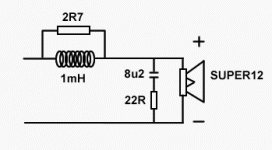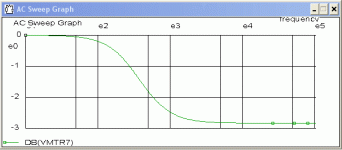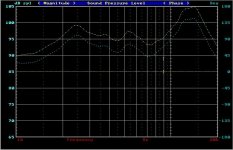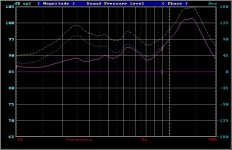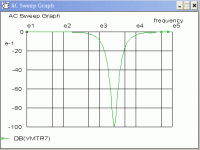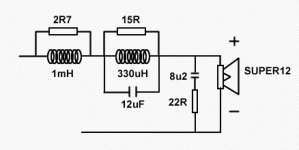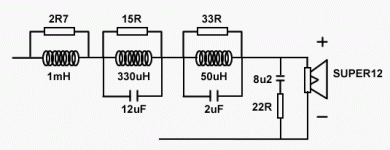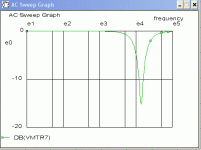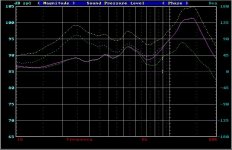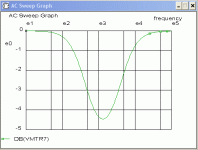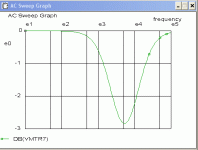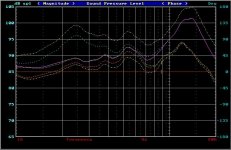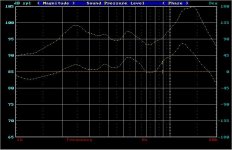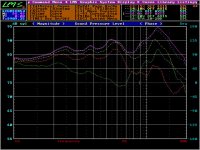Thanks again Michael for your advice.Gustavo
I strongly advise against 2 Super15 in one box. The main advantage of a FR is a point source. If you have 2 FR to increase SPL, they will interfere with each other. The end result is you will lose clarity.
I do not know because I never tested a Super15CF. But judging from the Super12CF, I expect the 15 to have the same problems.
I had hopes in the Super15CF as it have ''only'' 6dB up in the mid range against 10dB in the Super12CF.
Regards, Gustavo
Step 2 - Shelving Filter
A Contour Filter attentuates all the highs to the same level of the woofer frequencies.
The Spice graph shows the electrical behaviour with a 7 ohm resistive load.
LMS Gated Sweep from 1K-20K shows actual acoustic response of filter. As predicted by Spice, attenuation is about -3dB.
Filter Values are 1mH+2R7.
A Contour Filter attentuates all the highs to the same level of the woofer frequencies.
The Spice graph shows the electrical behaviour with a 7 ohm resistive load.
LMS Gated Sweep from 1K-20K shows actual acoustic response of filter. As predicted by Spice, attenuation is about -3dB.
Filter Values are 1mH+2R7.
Attachments
Step 3 - 2K5 Notch
The most serious peak is attacked first. A fairly deep (-10dB) Notch centered at 2K5 is applied. Width of the Notch Filter is adjusted to attenuate the adjacent frequencies. LMS Sweep confirms sideband attenuation.
The most serious peak is attacked first. A fairly deep (-10dB) Notch centered at 2K5 is applied. Width of the Notch Filter is adjusted to attenuate the adjacent frequencies. LMS Sweep confirms sideband attenuation.
Attachments
Nice work! Now, if only there were a line-level design, 'cause all these speaker-level contouring features add up! Who's got the inclination to develop a transistor-buffered contouring circuit based upon Michael's excellent work?
Step 4 - 14K Notch
Time to add some icing. A -15dB Notch at 14K reduces the cone breakup to a more acceptable level. Component Values are 50uH + 2uF + 33R
During listening test, I detected a peak somewhere near the 1K region. Certain piano notes are slightly emphasized. Very irritating to listen to.
Time to add some icing. A -15dB Notch at 14K reduces the cone breakup to a more acceptable level. Component Values are 50uH + 2uF + 33R
During listening test, I detected a peak somewhere near the 1K region. Certain piano notes are slightly emphasized. Very irritating to listen to.
Attachments
A -15dB Notch at 14K reduces the cone breakup to a more acceptable level.
A more accurate statement would be that the notch filter reduces its visible contribution to the frequency response. The break up mode is still there.
dave
Hi dave
Thanks for your input. You are absolutely right, the cone breakup is still there, just not so severe. I contemplated on using a 3rd - 4th order LP at 10K but decided to notch the frequencies instead.
Thanks for your input. You are absolutely right, the cone breakup is still there, just not so severe. I contemplated on using a 3rd - 4th order LP at 10K but decided to notch the frequencies instead.
Step 5 - 1K2
Unlike the previous filters which are sharp and narrow, this filter is quite broad with only -5dB attenuation at 1K2. Values are 1.5mH + 10uF + 4.7 ohms. Speaker sounds much better now. Vocals don't sound nasal and piano sounds more natural.
Unlike the previous filters which are sharp and narrow, this filter is quite broad with only -5dB attenuation at 1K2. Values are 1.5mH + 10uF + 4.7 ohms. Speaker sounds much better now. Vocals don't sound nasal and piano sounds more natural.
Attachments
Final EQ
There is still one final adjustment. I do not listen at 1 Meter. My normal listening position is about 10 ft. At this distance, the balance is off. Vocals are slightly recessed and losing some of the highs. Sounds a bit like background music.
To bring it back up to what is in the actual recording (I use a pair of Grado SR80 and AKG K240DF headphones for referencing), I tweaked the zobel to "lift" the vocals and highs. The correct balance snapped in at 15 ohms. Final Zobel value is at 15 ohms + 8.2uF.
In the LMS plots, we can compare the Raw Super12(without any EQ) to the the one with Full EQ applied (lower plot).
Massive improvement in sound quality.
There is still one final adjustment. I do not listen at 1 Meter. My normal listening position is about 10 ft. At this distance, the balance is off. Vocals are slightly recessed and losing some of the highs. Sounds a bit like background music.
To bring it back up to what is in the actual recording (I use a pair of Grado SR80 and AKG K240DF headphones for referencing), I tweaked the zobel to "lift" the vocals and highs. The correct balance snapped in at 15 ohms. Final Zobel value is at 15 ohms + 8.2uF.
In the LMS plots, we can compare the Raw Super12(without any EQ) to the the one with Full EQ applied (lower plot).
Massive improvement in sound quality.
Attachments
Some quick questions from the peanut gallery..
To lift the vocals couldn't you remove the shelving filter rather than change the zobel?
Would changing the inductor in the 15k filter from 50uH to 25uH lift the 8k dip without leaving a peak at 10k?
Thanks
To lift the vocals couldn't you remove the shelving filter rather than change the zobel?
Would changing the inductor in the 15k filter from 50uH to 25uH lift the 8k dip without leaving a peak at 10k?
Thanks
Thanx for all you efforts Micael... an awful lot of cross-over in there, sort of defeats many of the goals of a FR speaker. I doubt my little SE amp would like it either.
I took the liberty of redrawing your graph to better compare before and after.
dave
I took the liberty of redrawing your graph to better compare before and after.
dave
Attachments
Originally posted by netbug
To lift the vocals couldn't you remove the shelving filter rather than change the zobel?
I am afraid not. If the shelving filter is removed, all frequencies ahead will not be attenuated. This will be much too bright. The zobel is more elegant, it allows me to tilt whereas the shelving filter is "lift all" like in a preamp tone control.
If you prefer to leave the zobel unchanged, then adjust the shelving filter. It only requires a slight lift, maybe 1dB up.
Would changing the inductor in the 15k filter from 50uH to 25uH lift the 8k dip without leaving a peak at 10k?
You can use this EQ circuit as a starting point and make improvements from here. It doesn't solve all the problems but at least the Super12 now sounds quite decent. Even likable at times.
Thanx for all you efforts Micael... an awful lot of cross-over in there, sort of defeats many of the goals of a FR speaker
Hi dave
You're most welcomed. I agree wholeheartedly. Its kind of silly. The reason for using a FR is so that one don't even see any component let alone a bunch of them.
This came about because a close friend sent me his Super12CF. I had a quick listen and couldn't believe it was so far off. One thing led to another and this is the final result. At least he doesn't have to mothball them. In fact, he's quite excited to listen with the EQ that I came up with.
On a personal level, I don't use speakers with response like this. I am very particular. I rather pay more and have the manufacturer iron out the difficulties than me solving their problems.
This EQ is valuable for existing owners of the Super12CF. If they are dissatisfied with the performance, a small investment will bring the speakers to life. The Super12CF may be fine for some but for those that are serious with their Hi-Fi, I suggest they factor in the cost of an EQ network if they intend to purchase the Super12CF.
Is it worth it, I honestly cannot comment. After EQ, its much better. It has its good points. "Big" sound, Lifelike, deep soundstage. Very different from my Seas ER18 with a Vifa XT25. Its certainly not of the same class as my Radian 12"Coax.
Many thanks for taking the time to redraw the graphs. They don't look that much different but audibly, the improvement is quite good. Perhaps some owners of this Super12CF can offer their views after applying the EQ.
It depends on the listener. All these plots are taken at 1 meter. The top plot, the one that is on-axis, the speaker has been adjusted for my listening distance of 10ft. If the mic is placed at 10ft, the response will look more like the yellow plot.
Some listeners are fine with flat response at 1 meter. For me, at 10 ft listening distance, a speaker with a flat response at 1 meter sounds very dull. The falloff in the highs are too much.
From the plots, we can verify that as long as it is not more than 10 degrees off axis, the response maintains its shape, only the highs fall in level. So, depending on one's listening distance and hearing abilities, one can simply rotate the speakers slightly for the highs to suit his taste. As long as it is within 10 degrees, there are no drastic changes. It is the same as on-axis, just more or less highs.
Some listeners are fine with flat response at 1 meter. For me, at 10 ft listening distance, a speaker with a flat response at 1 meter sounds very dull. The falloff in the highs are too much.
From the plots, we can verify that as long as it is not more than 10 degrees off axis, the response maintains its shape, only the highs fall in level. So, depending on one's listening distance and hearing abilities, one can simply rotate the speakers slightly for the highs to suit his taste. As long as it is within 10 degrees, there are no drastic changes. It is the same as on-axis, just more or less highs.
Agreed. I wasn't satisfied with the highs that the F200A or the AER driver provided, even on axis because they were more or less flat (commendable engineering, but...) It seems that I desire a strong response in the 8-12 khz area with a gentle rolloff after that. Why do I? I have no idea.😕
This is quite normal. It is not that you cannot hear the highs.
Consider what happens when sound travels through air. It loses energy along the way. When all the energy are lost, no more sound. The farther we are, the softer the sound.
In the audio bandwidth (20Hz-20KHz), we have different frequencies at work. Trouble is, these frequencies do not lose their energy equally. The ones with the longest wavelengths take longer to lose their energy. Therefore, they travel the farthest. The shorter the wavelength, the less the distance travelled.
When we use 1Watt/1Meter for measurements, it serves as a fixed reference point, so that we can compare one product with another. Unfortunately, for most of us, we do not listen to our speakers at 1 meter. Generally, I would say 6 to 10 ft is common.
At such a distance, we can detect the losses in the high frequencies. If the highs and the lows are at the same strength from 1 meter to 3 meters (10ft), then there would be no change if we measure them.
We can easily test this with a spectrum anlayzer. Use a 31-band eq and calibrate a speaker for flat response, up to 20K, at 1 meter. Without changing the eq, move the mic to 3 meters. Ajust the pink noise back up to the center row of leds. You will see the highs are not at the "0" level. It gradually drops to -3dB or more. The higher the frequencies, the more it drops. And this is only 3 meters.
That's why a speaker that measures flat at 1 meter sounds dull. When you listen to it 8 ft away, it lacks definition.
Consider what happens when sound travels through air. It loses energy along the way. When all the energy are lost, no more sound. The farther we are, the softer the sound.
In the audio bandwidth (20Hz-20KHz), we have different frequencies at work. Trouble is, these frequencies do not lose their energy equally. The ones with the longest wavelengths take longer to lose their energy. Therefore, they travel the farthest. The shorter the wavelength, the less the distance travelled.
When we use 1Watt/1Meter for measurements, it serves as a fixed reference point, so that we can compare one product with another. Unfortunately, for most of us, we do not listen to our speakers at 1 meter. Generally, I would say 6 to 10 ft is common.
At such a distance, we can detect the losses in the high frequencies. If the highs and the lows are at the same strength from 1 meter to 3 meters (10ft), then there would be no change if we measure them.
We can easily test this with a spectrum anlayzer. Use a 31-band eq and calibrate a speaker for flat response, up to 20K, at 1 meter. Without changing the eq, move the mic to 3 meters. Ajust the pink noise back up to the center row of leds. You will see the highs are not at the "0" level. It gradually drops to -3dB or more. The higher the frequencies, the more it drops. And this is only 3 meters.
That's why a speaker that measures flat at 1 meter sounds dull. When you listen to it 8 ft away, it lacks definition.
- Status
- Not open for further replies.
- Home
- Loudspeakers
- Full Range
- Audio Nirvana Super 12 Cast Frame measured T/S
